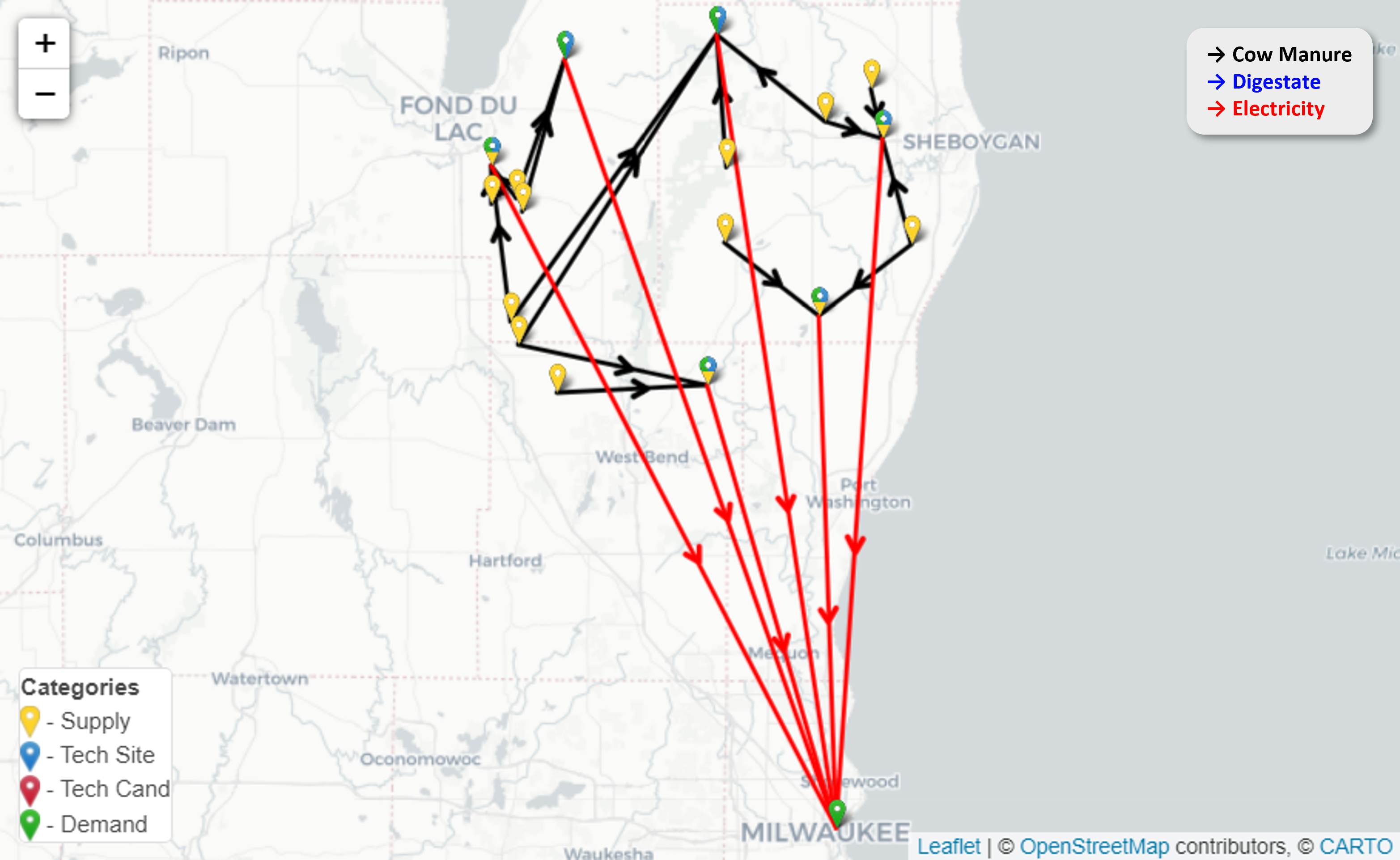Biogas Supply Chain Under Order No. 2222
Background
On September 17, 2020, the Federal Energy Regulatory Commision (FERC) issued Order No. 2222. This policy removed the cost barriers that were limiting distributed energy resources (DERs), allowing them to compete alongside traditional electricity resources.
DERs are local, small-scale power generation or energy storage technologies connected to the power grid. Some examples of DERs are rooftop solar panels, biomass generators, fuel cells, wind turbines, and electric vehicles. With Order No. 2222, these technologies will be more easily obtainable by the average citizen. An increase in DERs allows the power grid to become more flexible and resilient since there is less reliance on centralized power generation sites.
This case study demonstrates the impacts of FERC Order No. 2222 through two scenarios, one representing the system before Order No. 2222 was issued and the other representing the system after. For both cases, we used a biogas supply chain (shown below) that uses raw cattle manure to generate electricity. The Power Generation technology represents the DERs, and the Electricity Cost Increase technology is a pseudo technology that simulates the cost barrier for DERs.

In our system, the supply nodes are CAFOs that supply manure to the technology sites. The technology sites can then process the manure into digestate (a waste product) and electricity. In order to simplify the system, we only used data from a small subarea of Wisconsin, and we consolidated the electricity demand into a single point located in Milwaukee, WI; this allows us to greatly reduce the number of nodes, so the solver will be able to find a solution quickly. Additionally, we assumed that all of the technology sites already exist. This removes the investment cost barrier and allows us to only observe the effect of the policy.
Old Policy
Before FERC Order No. 2222 was issued, DERs faced an extra cost barrier compared to traditional energy resources. This cost barrier is represented in the model as a pseudo technology that increases operating costs. For this model, any electricity generated by the Power Generation technology is forced to go through the Electricity Cost Increase technology.
The figure below shows the results of the system as solved by ADAM. All of the manure from the supply nodes are processed into electricity. The electricity goes through the pseudo technology, representing a price increase, and then it is consumed by the Milwaukee demand node.

Without any other data to compare this to, it is difficult to interpret. Thus, let us look at the results for the New Policy case.
New Policy
For the new policy case, the pseudo technology was removed in order to simulate the cost barrier reduction. On the surface, the product flow results (left) of the new policy appear to be the same as the old policy. However, the quantitative results (right) show that the new policy has much lower costs than the old policy.

Since the Milwaukee demand node is constant (i.e. it buys the electricity at the same price and is at the same location), both scenarios have the same revenue and transportation costs. The main category in which the old and the new policy differs is the operating cost. The old policy, which includes the extra cost barrier, has a much higher operating cost than the new policy. The operating cost of the old policy alone was able to surpass the revenue generated from selling the electricity. As a result, the old policy has a negative social welfare, indicating that the cost barriers for operating DERs are too high to be profitable, and as a result, many customers are barred from entering the market. On the other hand, the new policy has much lower operating costs, so generating electricity is profitable (social welfare is positive), and more customers would be willing to install DERs.
Conclusion
Before FERC Order No. 2222 was issued, the costs of DERs were too high in order to be profitable. As a result, very few people had DERs installed in their homes despite their many benefits. In order to encourage citizens to install DERs, the FERC established Order No. 2222 which removed some of the cost barriers of DERs.
This case study demonstrated the effects of Order No. 2222 using a biogas supply chain limited to a small region of Wisconsin. Based on the case study, the impact of Order No. 2222 seems very promising. With a lower cost barrier, more DERs will be installed, and that will contribute to a more distributed and flexible electricity grid. Additionally, a larger proportion of the electricity market will come from sustainable and locally-generated energy sources.
Although these results provide a good start to understanding the impacts of Order No. 2222, there is still much to improve on. The models run in this case study contain many simplifications and assumptions, and thus they do not capture many of the complicated relationships of the real world. In this case study, we only looked at technology sites that were already installed. A possible improvement on this model is adding technology candidates to the system and observe whether Order No. 2222 lowers the cost barrier enough such that the investment cost and the operating cost of the equipment can be overcome.